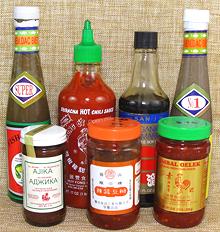
SAFARI
Users
Adjika
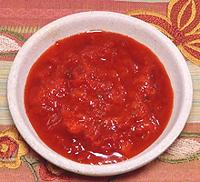 [Armenia, Georgia, Azerbaijan]
[Armenia, Georgia, Azerbaijan]
This extremely tasty Sauce / Condiment / Spread is said to have originated
in Azerbaijan, but since I live across the street from the western capital of
Armenia, I list that country first. If I lived in Azerbaijan, I would not
admit such a thing as Armenia even (or ever) existed. Pagan Armenia was a
world power, until it converted to Christianity (the first country to do so)
and went into decline. Imported form Armenia, this Adjika comes in Mild and
Hot, but the Hot certainly doesn't rate as "Hot" by Southern California
standards. I don't use the Mild because it's relatively uninteresting. Ingred:
red hot chili peppers, tomato paste, garlic, vegetable oil, salt, greens.
Banana Ketchup / Sauce
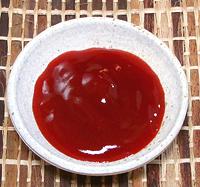
[Tamis Anghang (Philippine)]
This product, very popular in the Philippines, is called "Banana Ketchup" there, but in the Unites States it must be labeled "Banana Sauce". In the U.S. "Ketchup" is a standardized formula and nothing that doesn't meet the formula can be called "Ketchup". This was done so manufacturers of ketchup didn't have to reveal its extremely high sugar content (more sugar than ice cream - that's why the kids like it so much).
Banana Ketchup is colored red and put up in ketchup style bottles to
make it more acceptable as a lower cost ketchup substitute. The taste and
texture are a little different from our ketchup, but not too much.
Ingred: banana, water, sugar, vinegar, iodized salt, modified starch,
onion, spices, garlic, 0.08% sodium benzoate (E211) as preservative,
FD&C Yellow #6 (E110) and FD&C Red #40 (E129) as artificial
coloring.
Details and Cooking.
Chili Sauces
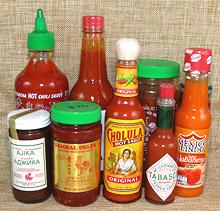 Found in Central and South America and the Caribbean, chili peppers
were carried throughout the world by the Spanish (specialzing in milder
varieties) and Poturguese (specializing in hotter ones). They lend
themselves to a number of sauces and condiments beyond counting. This
very important category has its own Chili
Sauces & Potions page covering some that are particularly
important in North America.
Found in Central and South America and the Caribbean, chili peppers
were carried throughout the world by the Spanish (specialzing in milder
varieties) and Poturguese (specializing in hotter ones). They lend
themselves to a number of sauces and condiments beyond counting. This
very important category has its own Chili
Sauces & Potions page covering some that are particularly
important in North America.
Fish Sauces
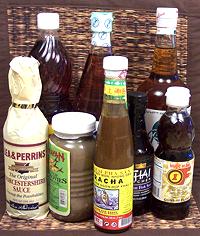 Fish sauces were as essential to the cuisine of the Roman Empire as they
are in Southeast Asia today. They are now increasingly important in
North America, not only because of the increasing popularity of
Southeast Asian cuisines, but are being incorporated into California
cuisine, and other innovative cuisines across the continent. This very
important category has its own Fish
Sauces page.
Fish sauces were as essential to the cuisine of the Roman Empire as they
are in Southeast Asia today. They are now increasingly important in
North America, not only because of the increasing popularity of
Southeast Asian cuisines, but are being incorporated into California
cuisine, and other innovative cuisines across the continent. This very
important category has its own Fish
Sauces page.
Mayonnaise
 [Mayo]
[Mayo]
Used worldwide, this is an emulsion of Oil, Water, Egg, and a souring
agent. It has a creamy texture, and is used a sandwich spread, condiment,
and dressing. It is also included in many recipes and as the base for more
complex sauces, condiments, and dressings. For details see our
Mayonnaise page.
Maggi Seasoning

[Jugo (Mexico), Maggi Würze (Germany)]
This important seasoning, was invented in India by Mannat Maggi, with manufacturing moved to Germany in 1897. It has found a worldwide market and you will find it called for in many recipes, especially from Southeast Asia, where it is also a table condiment. Its bottle and trade dress are widely imitated by Asian knock-offs. It is also very popular in Central Europe.
Magi is similar to soy sauce, but formulated to be more of a meat
broth analog. It originally contained soy, but soy was dropped around
2000. It is used in soups, stews and sauces, but also in salad dressings
and vegetable dressings. The brand is now owned by Nestlé, and
is distributed in North America by Nestlé USA.
Details and Cooking.
Mustard, Prepared

[Moutarde (France)]
A table condiment and recipe ingredient made from the seeds of various
Mustard plants (Sinapis alba (white mustard); Brassica juncea
(brown mustard); or Brassica nigra (black mustard). It is used
worldwide.
Details and Cooking.
Oyster Sauce
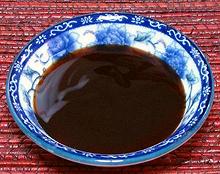 [Oyster Flavored Sauce (USA); Dau Hào (Viet); háo
yóu (Cantonese)]
[Oyster Flavored Sauce (USA); Dau Hào (Viet); háo
yóu (Cantonese)]
This is a very important Chinese sauce, also much used in Thailand,
Vietnam and Cambodia. It was invented accidentally by Lee Kum Sheung in
Guangdong in 1888. He founded the Lee Kum Kee company to market it.
Today it is made by many companies in Asia and elsewhere, in an
extremely wide range of qualities, some having very little association
with actual oysters. See Details and
Cooking for details and recommendations.
Shrimp Sauces & Pastes
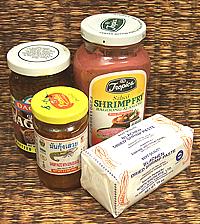
While well behind Fish Sauces in penetrating Western cuisines, these
sauces are essential for authentic reproduction of the cuisines of
coastal China and all of Southest Asia.This very important category
has its own Shrimp Sauces /
Paste page.
Soy Sauces
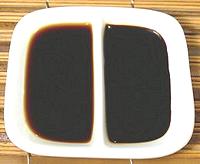 Techniques for fermenting soybeans to render them non toxic and edible
were developed in China. A byproduct of making soybean pastes was
developed into Soy Sauce, an ingredient and condiment soon adopted by
Korea, Japan and Southeast Asia. It has now become quite prominant in
North America as well. This very important category has its own
Soy Sauce page.
Techniques for fermenting soybeans to render them non toxic and edible
were developed in China. A byproduct of making soybean pastes was
developed into Soy Sauce, an ingredient and condiment soon adopted by
Korea, Japan and Southeast Asia. It has now become quite prominant in
North America as well. This very important category has its own
Soy Sauce page.
Yellow Soy Bean Sauce

[Nuoc Tuong (Viet)]
Sometimes called "Brown Bean Sauce or "Soy Bean Paste", this sauce is
made from fermented yellow soy beans. It is a very common ingredient
in Thai and Vietnamese cuisine and available in markets serving
Southeast Asian communities. The brown one to the left is a reasonable
substitute for fish sauce in many vegetarian dishes. This category
has its own Yellow Bean Sauce
page.
Thai Curry Pastes

Curries are very popular in Thailand, but they differ from Indian
Curries in that they are fresh pastes, not made from dried spices.
Several of them can be had commercially in North America, but all
are better made at home. The Clovegarden site has recipes for each.
They are listed here in order of popularity in Thailand.
Red Curry Paste
[Krueng Gaeng Peht (Thai Paste)] Red are the most popular curries in Thailand, and are in hotness midway between green curries and yellow curries.Red Curry Sauces:
These "convenience" products can't be used in real Thai recipes. They also vary widely in quality.Green Curry Paste:
This is the hottest of the Thai pastes, used for Green Curries, second most popular to Red Curries.Yellow Curry Paste:
The least hot of the Thai curries, yellow curry is a Thai take on Indian curries, but still based on a fresh paste.Panang Curry Paste
[Phanaeng, Phanang, Panaeng] from the Malaysian island of Panang, this curry has been enthusiastically adopted by the Thai.Mussamun Curry Paste:
[Massaman, "Muslim curry"] possibly patterned after the rich Mughal cuisine of Hyderabad in India or introduced by Muslim merchants, it is quite different from other Thai curries.Hot Sour Curry Paste:
This curry paste is fairly hot, but not sour. It gets its name from the sour soups it is used in.
Tomato Ketchup
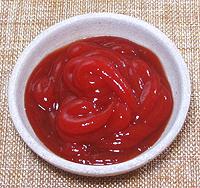 [Catsup; Kekap (Malay); Ketçap (Turk)]
[Catsup; Kekap (Malay); Ketçap (Turk)]
Ketchup is held in high favor by children, because it has more sugar
than ice cream - it's sort of tomato flavored candy. By federal law,
if your product doesn't have that much sugar it can't be called
"ketchup". This was a ploy by the food industry to "standardize" the
product so they didn't have to reveal on the label that it was about
1/3 sugar (other ingredients are water, salt, vinegar, spices, and, yes,
tomatoes). For details see our
Tomato Ketchup page.
Za'atar - Spice Mix
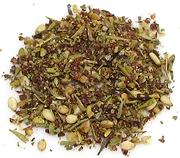
This is a very important spice mix in the Levant and Middle East, both
as an ingredient, and as a table condiment. Supposedly, it is based on
the herb Za'atar (Origanum syriacum), but most today is made
from Thyme, Oregano and Marjoram because the supply of Za'atar is
no longer sufficient. Other ingredients are toasted Sesame Seeds,
Sumac for sourness, and sometimes salt. Some commercial versions may
included toasted wheat flour - not good for Celiacs. Some versions
also include savory, cumin, coriander or fennel, and one distinctly
Palestinian version includes Caraway seeds. In the region, this mix
may be also made with fresh herbs. The photo specimen is from our
Lebanese style recipe Za'atar
- Herb Mix. See also
Details and Cooking.
